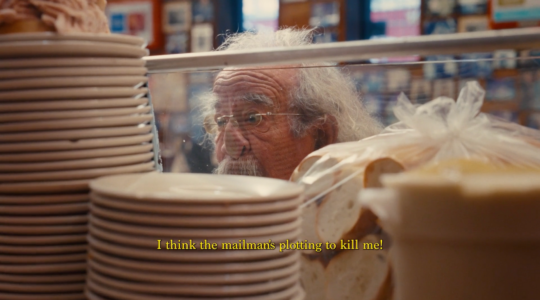Aleksander Ford was a Jewish-Polish filmmaker whose career summed up the bloody 20th century. He enjoyed one of the rare happy endings, thanks to a mixture of luck and foresight, but it is clear from his best film, “Border Street” (1949), that he knew all too well how rare his good fortune was. “Border Street,” which will have a rare U.S. showing on Nov. 18, was the first fiction feature to attempt to portray the Warsaw Ghetto uprising, and Ford undoubtedly knew many of the men and women who had perished in the flames that engulfed the ghetto.
Unlike those Jews, he had read the tea leaves accurately. A prominent director since the silent era, the Ukraine-born Ford had a good idea what the Nazi invasion would mean and as a leftist had no problem with going to the Soviet Union, where he immediately joined the first Polish volunteer unit formed on Soviet soil and made numerous war documentaries, including “Majdanek,” (1944), the first film about the death camps.
When the war ended shortly after, Ford gratefully returned home, only to find his Poland in smoking ruins. (In fact, the Nazis had so utterly destroyed Warsaw that “Border Street” was actually filmed in Czechoslovakia because it would have been impossible to shoot where the film was set.) The film industry was as devastated as the rest of Poland, and Ford took an active hand in putting it back on his feet. Only when the job was completed did he finally go back to the director’s chair for “Border Street.”
“Border Street” is one of a small group of East European films made within five years of the end of the war that face the horrors of the Shoah with comparative candor. Along with “The Last Stop” and “Distant Journey,” the Ford movie reaches a level of honesty that would soon disappear from screens east and west for several decades. As film historian Annette Insdorf noted in an e-mail interview earlier this year, “There was neither cinematic silence in Europe, nor a large group of films about the Holocaust. Rather, in a country like Poland, which already had a rich cinematic tradition, directors such as Wanda Jakubowska (“The Last Stop”) and Aleksander Ford (“Border Street”) made powerful dramas.”
“Border Street” has a straightforward structure, opening with the ruins of what was once Warsaw but now is, as a voiceover narrator says, “streets turned into cemeteries.” Before the war, we are told, it was an ordinary street like hundreds of others in the city, and we dissolve to 1939 and a seemingly typical day for the teens and children of this unexceptional courtyard overlooked by a large apartment building.
Using a series of gliding lateral camera movements, Ford gracefully unifies the space of the courtyard and the rows of windows that overlook it. Like Jean Renoir, he creates this small community as a microcosm of the larger city, an intricate and intimate network of interlocking relationships from friendship to enmity, necessity to obligation. The chief protagonists of this deliberately collective melodrama are David (Jurek Zlotnicki), a small Orthodox Jewish boy; Fredek (Eugeniusz Kruk), an obnoxious ethnic German whose father is quick to embrace the Nazis; Jadzia (Maria Broniewska), the local doctor’s kindly daughter, who discovers that her father has hidden his Jewish identity; Bronek (Tadeusz Fijewski), the supposed delinquent who turns out to have a heart of gold and the temperament of a born resistance fighter; and Wladek (Dionizy Ilczenko), along with Jadzia and Bronek a sort of third musketeer who slowly comes to realize that the Jews don’t deserve the torments being heaped on them.
If that makes the film’s drama seem rather pat, well frankly it is. But what sets “Border Street “ apart from almost any other film about the Second World War is that it presents a moral universe in which you judge someone’s character by how they treat Jews, and the Jews themselves are presented as heroic, from fighters like David and his uncle Natan, who is a Polish army veteran as well as organizer of the Ghetto’s ragtag armed resistance, to David’s grandfather, a pacifistic old man who lies to the Gestapo and dies reciting prayers as the Ghetto burns. Although Ford treats Natan’s heroism as a part of his dual nature as Jew and Pole — as the Ghetto burns he stands defiantly between Jewish and Polish flags — and hence an avatar of the socialist struggle to come, Grandfather’s death with its insistence on faith is every bit as noble.
Of course, this was a position that would be unsafe to have in Stalinist Poland for very long. Ford would continue to work steadily in his native film industry but “Border Street,” with its affirmative portrayal of Jews is unique in his filmography. More typical, perhaps, is his 1960 film “Knights of the Teutonic Order,” which became available on DVD earlier this year. This is a big-budget film, adapted from a novel by fabled Polish patriot Henryk Sienkiewicz, so clearly Ford was considered a good soldier in Polish film circles. And it is certainly a lively piece of work, a spirited paean to Polish nationalism in the face of German perfidy as represented by the eponymous medieval order. But it has none of the power or feeling of “Border Street”.
In order to achieve those qualities again, Ford would finally have to leave Poland after one more anti-Jewish campaign by its government. He lived in Israel and the U.S., dying in Naples, Fla., in 1980. But his last two films, an adaptation of Solzhenitsyn’s “The First Circle” and a biopic about the famous Jewish martyr Janusz Korczak, are a final fierce statement of his hatred of both the Nazis and the Stalinists and his own brand of Jewish pride.
“Border Street” will be shown at the Museum of Jewish Heritage (36 Battery Place) on Sunday, Nov. 18 at 2:30 p.m. It will be introduced by professor Stuart Liebman of the CUNY Graduate Center and there will be a post-screening discussion. For information, call (646) 437-4200 or go to www.mjhnyc.org.
“Knights of the Teutonic Order” is available on DVD from Second Run DVD at http://www.secondrundvd.com.
The New York Jewish Week brings you the stories behind the headlines, keeping you connected to Jewish life in New York. Help sustain the reporting you trust by donating today.




